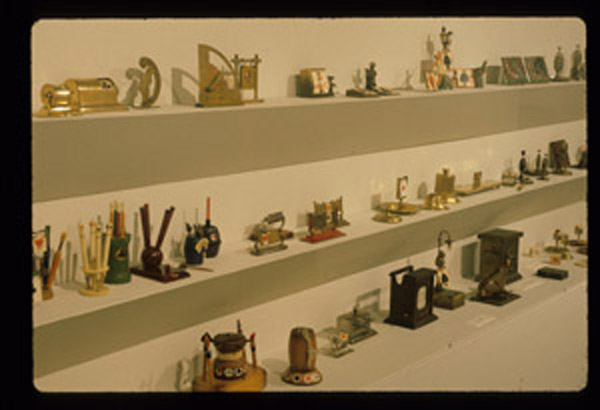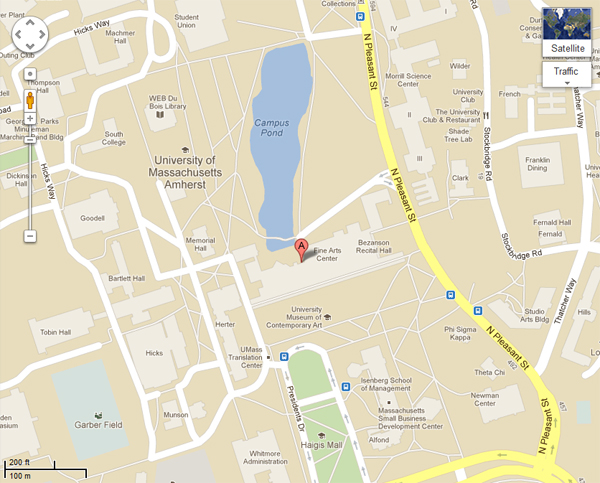What's Trump?
Indicators from the Collection of Joan Schepps
February 1 - March 14, 1997

Almost anything can form the embryo of a collection, and for an avid bridge player, as Joan Schepps is, a small porcelain chicken with a clown collar and the symbols of the four card suits provided the impetus. The chicken's beak moves to point to club, heart, spade, diamond, and no trump. Found at a flea market at Brimfield, Massachusetts, Schepps had no idea what this object was, nor did the dealer, but she "couldn't leave it there," and with that a collection was born. After her third find she was hooked, and now she has over 600 of the tiny gadgets, no two of which are exactly alike. What's Trump? Trump Indicators from the Collection of Joan Schepps, features a selection of over 400 of these whimsical objects.
Joan Schepps, a resident of Holyoke, Massachusetts, and a Silver Life Bridge Master (which means she has earned over 1,000 master points), has amassed perhaps the largest collection of trump indicators in the world. These relatively unknown gadgets were used in the game of whist and in early forms of its successor, bridge, to remind players of the trump suit. Because there was no bidding in whist, trump was decided by turning the 52nd card face up at the conclusion of the deal. This card, at the dealer's turn to play the first trick, was either played or added to the dealer's hand, thus becoming concealed. Since the trump suit was arbitrarily selected, one could easily forget which suit was trump. Trump indicators were made as tabletop reminders of the trump suit.

|
|
| Installation view, What's Trump? 1997, photography, Creative Services, University of Massachusetts |
Though very little is known or recorded about trump indicators, we know from their visual styles and subject matter that they were commonplace from the 1880s through the 1930s when whist was one of the most popular forms of urban entertainment worldwide, enjoyed by all social classes. The trump indicators on display in What's Trump? depict people, animals, occupations, sports, cartoon characters and forms of popular entertainment, paralleling the social history of the end of the 19th and beginning of the 20th centuries, particularly in Europe and America. Trump indicators can be dated by whether they indicate "no trump," since the earliest trump indicators had only the four suits as no trump didn't exist in the game of whist. Some can be dated from their materials -- Celluloid (copyright, 1870) and Bakelite, for example, were both early forms of plastic. Many can be dated from stylistic characteristics, whether Victorian or Art Deco, or their depictions of popular art characters from the comics of the day -- Jiggs, Felix the Cat, or from those of early animation -- Betty Boop, Mickey Mouse, W.C. Fields. Trump indicators are made of a range of materials, from silver and porcelain to simple hand-carved wood. Many have other uses besides indicating trump. Included in the exhibition are examples of trump indicators that doubled as jewelry, pencil holders, table brushes; there is a makeup compact and a measuring tape. Some were made to fold up for ease in traveling. All have moveable parts which flip, point or turn to indicate the suit, and some are mechanical. Reflecting the progress of mass production and consumption, trump indicators were also sold to tourists as souvenirs and doubled as advertisements for local companies.
The history of card-playing and playing cards reveals a bit of the background to the popularity of the game of whist and its predecessors. The earliest documented references to card games first appeared as legal prohibitions against playing them -- in the 14th century in Europe. With the advent of the woodcut and metal engraving in the 15th century, playing cards were being produced in Germany and Switzerland by the thousands. By 1430 they were reliably reported from Florence, Basle, Regensberg, Brabant, Paris and Barcelona. Without any constraints as to the representation of suits or figures, cards in those days took on imaginative variations of suits and courtly figures, and favored concrete objects from everyday life -- animals, birds, flowers or hardware. A pack would often contain one each of several categories linked by a chosen theme, typically hunting. By the latter part of the 15th century cards had become a growth industry and were standardized in design, in part because it was cheaper and quicker to make them. France is credited with inventing the suits we know and use today in about 1480.
Playing cards arrived in England in the 15th century where whist, the ancestor of the modern game of bridge, was born. Early versions of the game were variously called Triumph, Whisk, Ruff, Honours and Whist. By the 17th century whist had become very popular. In 1742 Edmond Hoyle described its rules in A Short Treatise on the Game of Whist -- the little book became a best seller and the game became a widespread form of popular entertainment and a respected form of intellectual pursuit.
Joan Schepps's collection of trump indicators has be been written about extensively in antiques and bridge newspapers and magazines, and it was the subject of Personal FX, a nationally televised program on collections and collectibles on July 11, 1996. Schepps founded the Holyoke Bridge Club in 1975.












